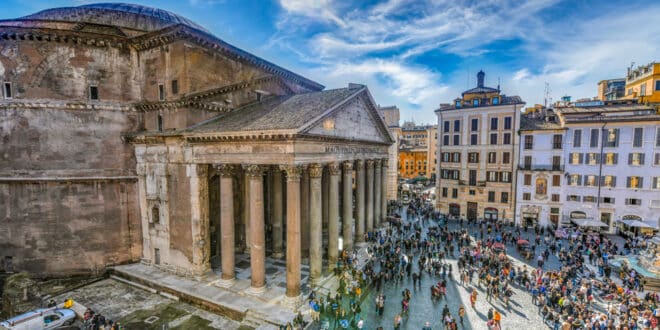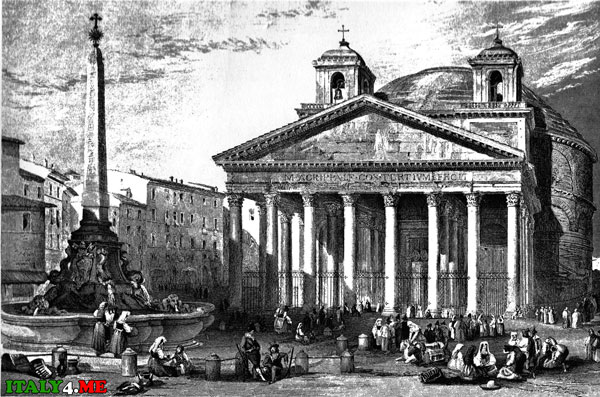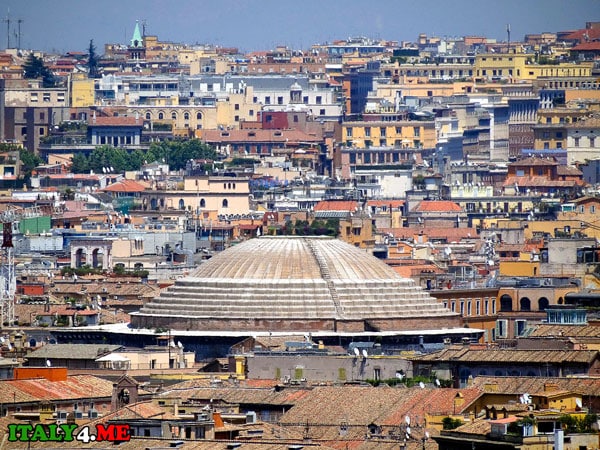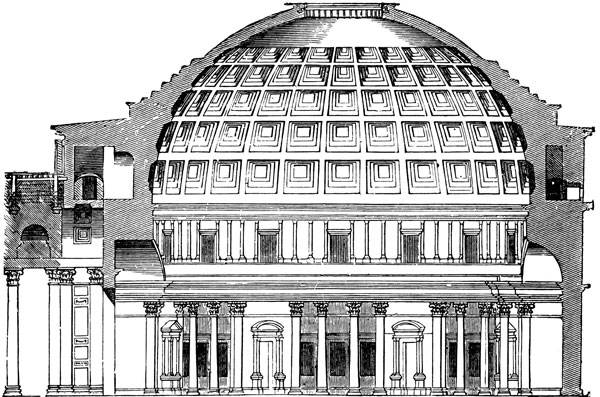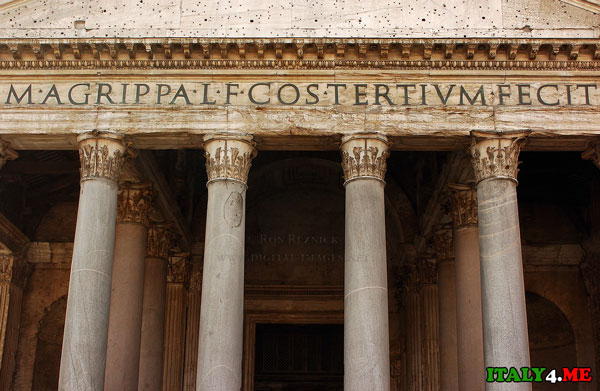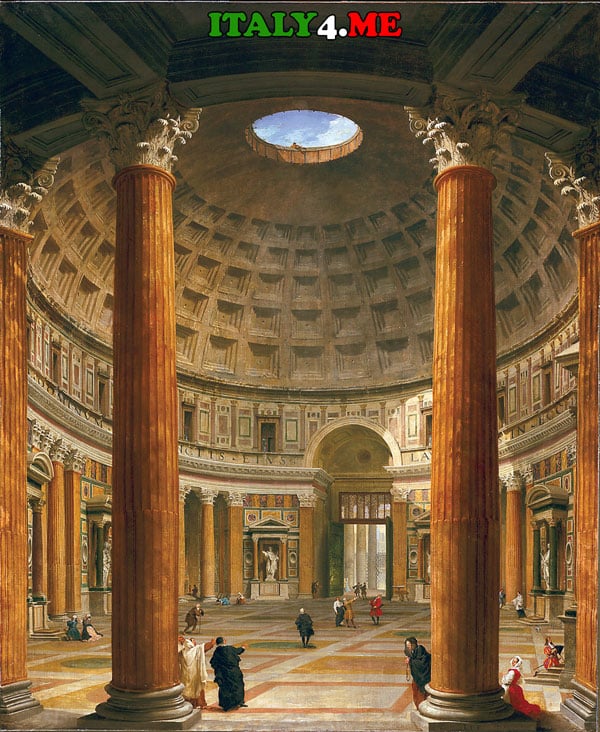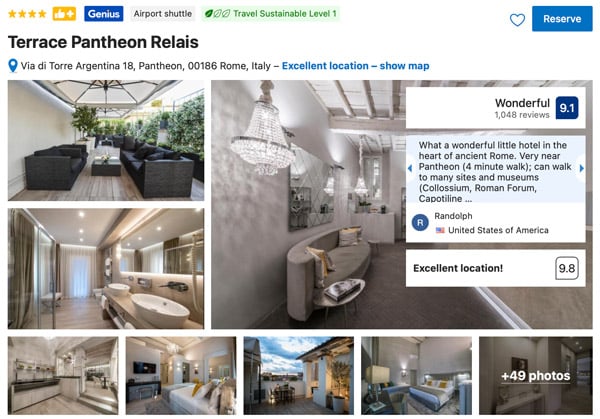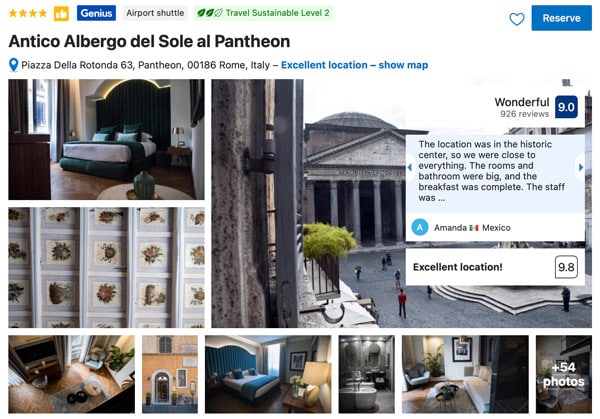The Pantheon in Rome is an ancient temple dedicated to the ancient Roman gods, embodying the grandeur of the Roman Empire. It is believed that it was constructed in the 2nd century AD on the site of a temple built in the 27th century BC by Marcus Agrippa. In the 7th century, the Pantheon was consecrated as a Catholic church. Today, this marvel of antiquity stands in the Piazza della Rotonda.
Page Contents
Description
The Pantheon consists of a massive rotunda topped by a hemispherical dome with a diameter of 147 feet (45 meters). Architects achieved a harmonious balance between the building’s height and its diameter.
Thanks to engineering calculations, the dome doesn’t oppress visitors with its weight; instead, it majestically rises, reminiscent of the sky.
The structure’s height is nearly equal to its diameter, reaching 138 feet (42 meters). A standout feature of the Pantheon is the 30-foot (9-meter) hole in the center of the dome, known as the “Eye of the Pantheon.” Through this opening, air and light enter the temple.
Eye of the Pantheon
Inside, the dome’s surface is adorned with 140 coffers. These decorative recesses not only have an aesthetic but also a structural value.
They significantly reduced the weight of the vault. It has been estimated that the dome weighs about 5,000 tons. As the height of the vault increases, its thickness and weight decrease. For instance, the concrete’s thickness at the base is 6 meters, while near the Eye of the Pantheon, it’s just 1.5 meters.
Entrance
A portico made of sixteen granite Corinthian columns accentuates the temple’s entrance.
You can enter the temple through a Roman portal from the Roman era. The walls supporting the dome are internally clad with marble and divided into two tiers. The lower tier, in turn, is split into seven identical niches, further lightening the construction.
What does the Latin inscription on the Pantheon mean?
The Latin inscription on the Pantheon, “M.AGRIPPA.L.F.COS.TERTIUM.FECIT,” translates to “Marcus Agrippa, son of Lucius, three times consul, made this.” It’s a fascinating detail, considering the building that stands today wasn’t the original Pantheon that Marcus Agrippa had constructed.
Origin of the Inscription
Marcus Vipsanius Agrippa was a close friend and son-in-law of Emperor Augustus. In his role as aedile, Agrippa was responsible for maintaining public buildings and other civic responsibilities in Rome. In 27-25 BC, during his third consulate, Agrippa constructed the first Pantheon as a rectilinear, T-shaped structure, very different from the current rotund model we see today. This was part of Agrippa’s grand plan to beautify the city during the reign of Augustus.
The Fire and the Rebuilding
However, this original Pantheon was not destined to last. In 80 AD, a massive fire raged through Rome, severely damaging the Pantheon. It was rebuilt by Emperor Domitian, but unfortunately, his version was also destroyed by a fire in 110 AD.
Emperor Hadrian, known for his admiration of Greek culture and architectural passions, decided to rebuild the Pantheon in the early 2nd century AD. Today’s structure, completed around 125 AD, is Hadrian’s creation. However, in a gesture of respect and to maintain continuity with the city’s architectural past, Hadrian chose to retain the original inscription of Agrippa on the new building. It was an unusual move, as Roman emperors often preferred stamping their names and achievements on the structures they commissioned or restored.
Significance of the Inscription
By keeping Agrippa’s name on the Pantheon, Hadrian acknowledged the historical significance of the original builder and the initial structure. It creates a tangible link between the Pantheon’s origins and its later reincarnation. The inscription serves as a testament to Agrippa’s contributions to Roman architecture and civic life. It also exemplifies a rare humility on the part of Hadrian, an emperor not putting his name prominently on a structure as iconic as the Pantheon.
In summary, while the Pantheon we see today wasn’t built by Marcus Agrippa, the inscription symbolizes Rome’s architectural past and the individuals who contributed to its grandeur.
Burial Place of Great People
The Pantheon stands as a testament to the architectural prowess of Ancient Rome, withstanding time and change. Michelangelo revered it as an angelic creation, a sentiment echoed by countless artists and scholars captivated by its grandeur.
Raffaello Santi (Raphael)
The Renaissance maestro Raphael, expressed a wish to be interred within these walls, a site he perceived as a nexus between the mortal and the divine. His desires were honored upon his passing in 1520, marking a significant transition in the Pantheon’s role as a resting place for esteemed personalities.
Read more about the Renaissance in Italy.
Vittorio Emanuele II
The first king of a reunified Italy, Vittorio Emanuele II’s interment in 1878, was a poignant symbol of the country’s renaissance and unity. His tomb in the Pantheon fortifies the bond between Italy’s modern era and its ancient past.
Umberto I and Queen Margherita
Umberto I, who ascended the throne after Vittorio, and his consort, Queen Margherita, are also laid to rest here. Their shared tomb reiterates the connection between royalty and this ancient monument, underscoring the Pantheon’s significance in chronicling Italy’s rich tapestry of history.
Timeless Majesty: The Pantheon’s Architectural Legacy
From an architectural standpoint, the Pantheon is virtually the only monumental structure that harmoniously blends grandeur with grace. Its design profoundly influenced architecture in its own time and subsequent eras.
Despite the centuries of their losses and acquisitions, the Pantheon remains a testament to the grandeur of the Roman Empire.
How to Visit the Pantheon in 2023: Tickets and Operating Hours
The Pantheon is open daily from 9 a.m. to 7 p.m.
As of September 2023, a ticket costing 5 euros is required to visit the Pantheon. There are two ways to purchase tickets:
In a live queue on-site at the ticket office. Keep in mind that it can be pretty uncomfortable to stand in line for several hours, especially in the heat or during the rain.
Buy tickets online for 17 euros. Yes, you’re paying extra, but you save time and get an audioguide as a bonus. There are sometimes discounts online, so the extra cost is not that significant.
Reliable agencies for purchasing Pantheon tickets are tiquets.com and getyourguide.com.
Dress Code Inside the Pantheon and Visiting Rules
Despite being a former Roman temple, the Pantheon in Rome now functions as a Christian church known as “Basilica di Santa Maria ad Martyres.” As with many religious sites in Italy, there are some general dress code guidelines that visitors should adhere to when entering:
- Shoulders Covered: Both men and women should wear clothing that covers their shoulders. Tank tops, sleeveless shirts, or off-the-shoulder dresses/tops are generally inappropriate. If you’re wearing one, consider bringing a scarf or shawl to drape over your shoulders when entering.
- Knee-Length Attire: Shorts, skirts, and dresses should be at least knee-length. Avoid wearing very short shorts or mini-skirts.
No Hats: As a sign of respect, men should remove their hats upon entering. - Footwear: While there’s no strict rule about footwear, wearing comfortable shoes is advisable, as you might be standing or walking for a while. Closed shoes are preferred over flip-flops.
- Respectful Attire: Even though the Pantheon might not be as strict as some other churches in Rome, it’s always a good idea to dress modestly and avoid clothing with large logos, offensive graphics, or overly flashy designs.
- Behavior: Beyond the dress code, remember to maintain a respectful demeanor. This includes speaking in hushed tones, avoiding loud laughter, and refraining from using flash photography.
It’s always a good idea to err on caution and dress more conservatively when visiting religious sites in Rome and throughout Italy. It ensures you can gain entry and demonstrates respect for local customs and traditions.
10 Interesting Facts About the Pantheon to Amaze Your Friends
Visiting the Pantheon in Rome? This ancient architectural marvel has seen millennia go by, yet it stands majestically, drawing tourists from all corners of the globe. Delve deep into its past with these captivating facts, and you’ll be sure to impress and surprise your companions during your visit.
- Dedication to the Gods: The name ‘Pantheon’ is derived from the Ancient Greek words “pan” (all) and “theos” (god). Initially, it was believed to be a temple dedicated to all the Roman gods when it was constructed in 125 AD during Emperor Hadrian’s reign.
- Architectural Ingenuity: The Pantheon’s dome, to this day, remains the world’s largest unreinforced concrete dome. Its diameter is precisely equal to the Pantheon’s interior height: 142 feet, demonstrating perfect symmetry.
- Oculus Mystery: The dome’s central opening, the oculus, measures 30 feet in diameter and is the only natural light source. Surprisingly, when it rains, the water doesn’t flood the interior; the floor’s slight slope and 22 well-hidden holes ensure adequate drainage.
- Twice Rebuilt: Though Hadrian’s Pantheon stands today, it wasn’t the first. Two earlier Pantheons were constructed on the same site. The first was by Marcus Agrippa in 27-25 BC, destroyed by fire and then by Emperor Domitian, but it suffered the same fate.
- Christian Connection: In 609 AD, the Pantheon was given to Pope Boniface IV, who converted it into a Christian church. Today, it’s known as “Santa Maria ad Martyres,” dedicated to the Virgin Mary and all the martyrs.
- Eternal Rest for Greats: The Pantheon is not just an architectural wonder; it’s also the final resting place for several renowned individuals. Renaissance artist Raphael and Italian Kings Victor Emmanuel II and Umberto I are interred here.
- Pagan-Catholic Fusion: Many original Roman design elements remain despite its Christian conversion. This unique blend makes it a rare site where ancient pagan and Christian Rome intersect.
- Astounding Rotunda: The interior rotunda was a marvel in acoustics. If you drop a pin on one side of the oculus, someone standing on the other side can hear it, making it an early exploration of architectural acoustics.
- Unique Materials: The Pantheon’s construction is a mix of materials from various regions: the 16 grand columns in the portico were transported from Egypt, and the dome’s interior once boasted gilded bronze, which was unfortunately robbed in the 17th century.
- Surviving Antiquity: One reason the Pantheon remains intact is its continuous use throughout history. Whereas many ancient Roman structures were pillaged for their materials, the Pantheon’s evolution from temple to church saved it from such a fate.
With these fascinating tidbits, your visit to the Pantheon will be a visual treat and an enlightening historical journey.
Good Hotels Near the Pantheon
In the article “Where’s the center of Rome and how to choose the right hotel?”, I recommend booking a hotel as close to the Pantheon as possible. Most of the major attractions will be within walking distance, and the use of taxis and public transportation will be minimized. Based on tourist reviews and my personal experience, I have selected a few good accommodation options near the Pantheon:
Terrace Pantheon Relais – A thousand positive reviews
The Terrace Pantheon Relais offers a delightful bonus: a rooftop terrace with a view of St. Peter’s Cathedral dome in the Vatican.
Do plan to visit the terrace at sunset, grab a bottle of wine, and enjoy the majestic panorama of the Eternal City. The hotel has over 1,000 reviews with an average rating of more than 9, a phenomenal achievement.
Antico Albergo del Sole – Unique view of the Pantheon from the rooms
The main attraction of the Antico Albergo del Sole hotel is its unique view of the Pantheon and the adjacent Piazza della Rotonda.
Many rooms accommodate 3-4 people, making it an excellent choice for travelers with children.
Staying in this hotel for even just a few nights guarantees unforgettable pleasant memories for a lifetime.
The Pantheon Iconic – 5 stars in the heart of Rome
The modern and beautiful 5-star The Pantheon Iconic hotel with high service standards, is located right behind the Pantheon.
It boasts an ideal location, lavish breakfasts, a terrace with panoramic views of the temple domes, and a fitness center for guests. Several friends have stayed here multiple times, and I can confidently recommend it to all website readers.
The hotel also has a Michelin-starred restaurant. It’s recommended for special occasions.
Martius Private Suites – The perfect hotel for romantics
The Martius Private Suites offer a charming mix of the authenticity of traditional Roman interiors and modern details.
Pay attention to the ceilings adorned with frescoes and moldings, the sculptures, and the ancient columns at the entrance. Hundreds of delightful reviews confirm that it’s an ideal choice for lovers, romantics, and beauty enthusiasts.
I hope one of the above-listed hotels will be available during your visit to the Eternal City. You can always contact me for advice on planning your vacation in Italy on this page.
Check your Knowledge about the Roman Pantheon
Do you consider yourself an expert on the history of Rome? Try to answer these popular questions about the Roman Pantheon without peeking:
 Italy for me From Italy with love
Italy for me From Italy with love

